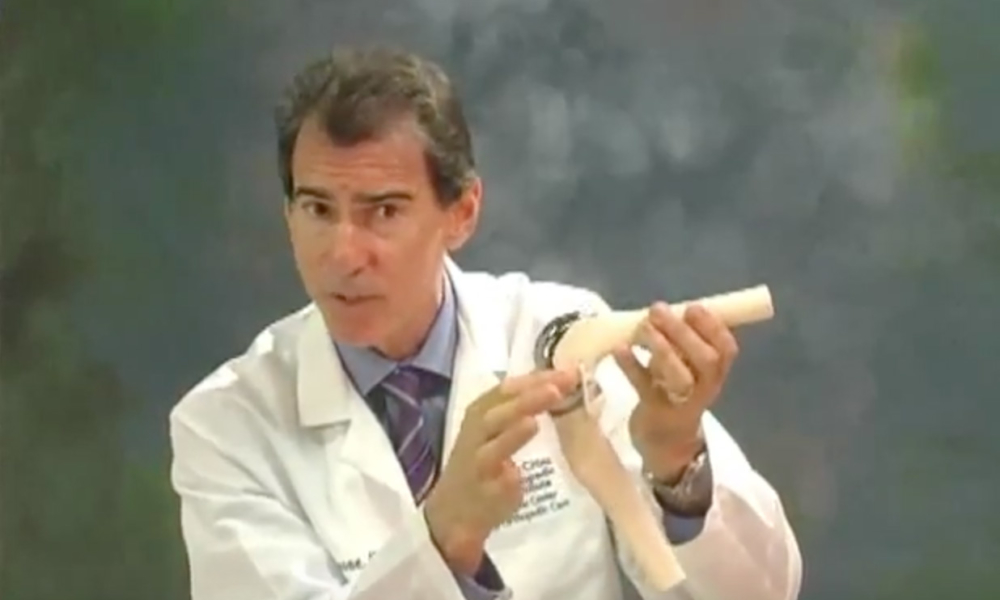Tag Archive for: TKR

Frequent Reader Questions about Knee Replacement Surgery
In my last Q&A blog post, I shared some of the most common reader questions about hip replacement surgery. Again, I will use a Q&A format to share some of the most-frequently asked questions and concerns about partial and total knee replacement surgery (PKR, TKR).
 https://holycrossleonecenter.com/wp-content/uploads/2019/09/after-standard-irrigation-and-drying.jpeg
4032
3024
Joseph Corsino
https://holycrossleonecenter.com///wp-content/uploads/2017/11/Leone-Center-Logo@2x.png
Joseph Corsino2019-09-05 14:59:172022-04-13 15:27:05No tourniquet total knee combined with novel device (CarboJet) improves implant stability.
https://holycrossleonecenter.com/wp-content/uploads/2019/09/after-standard-irrigation-and-drying.jpeg
4032
3024
Joseph Corsino
https://holycrossleonecenter.com///wp-content/uploads/2017/11/Leone-Center-Logo@2x.png
Joseph Corsino2019-09-05 14:59:172022-04-13 15:27:05No tourniquet total knee combined with novel device (CarboJet) improves implant stability.
The Unhappy Total Knee Replacement Patient: Figuring out What Is Wrong
/
46 Comments
Unfortunately, there are a significant number of people who have undergone total knee replacement (TKR) and are not happy with the result. Some studies estimate 20% or more fall into this category. Defining success or a “satisfactory result” can mean two very different things to an individual who had the total knee versus the surgeon who implanted it.
 https://holycrossleonecenter.com/wp-content/uploads/2017/05/south-florida-hospital-news-logo-1.jpg
67
311
Joseph Corsino
https://holycrossleonecenter.com///wp-content/uploads/2017/11/Leone-Center-Logo@2x.png
Joseph Corsino2017-05-11 11:12:522018-11-08 14:40:38South Florida Hospital News: Dr. Leone Heads New Clinical Trial for Total Knee Replacement
https://holycrossleonecenter.com/wp-content/uploads/2017/05/south-florida-hospital-news-logo-1.jpg
67
311
Joseph Corsino
https://holycrossleonecenter.com///wp-content/uploads/2017/11/Leone-Center-Logo@2x.png
Joseph Corsino2017-05-11 11:12:522018-11-08 14:40:38South Florida Hospital News: Dr. Leone Heads New Clinical Trial for Total Knee Replacement
Using Sensor Technology to Diagnose and Precisely Correct TKR Failures During Revision Surgery
In the last of three blog posts on the topic of unsatisfactory results post-TKR (total knee replacement), I will discuss using kinematic sensor technology to help me more precisely diagnose and correct a painful TKR.

Poor Results after TKR Due to Infection: Diagnosis and Treatment
For the second of three blog posts about post-surgical complications and unsatisfactory results after total knee replacement (TKR), I will discuss the critical need to rule out infection and if present, how to treat it.

Correcting TKR Post-Surgical Complications and Unsatisfactory Results
In my previous blog post, I shared that one out of five people (approximately 20 percent) who undergo Total Knee Replacement (TKR) are not satisfied with the result. I discussed the methods we use to understand the exact cause/causes of unsatisfactory outcomes, in order to improve these results.

Pain and Discomfort after Total Knee Replacement Surgery: Signs TKR Has Failed
Total knee replacement (TKR) has been one of the most successful surgeries developed over the past century and has improved the quality of life for countless people.

Using Kinematic Sensor Technology for Revision Total Knee Replacement (TKR)
Occasionally, even when a TKR “looks good on paper,” more surgery is required to correct and improve the existing outcome. If TKR revision truly is necessary, then the specific reason for the failure must be understood fully before it can be corrected.

Two Computer Systems Improve Total Knee Replacement Surgery
New techniques and technologies have been developed, which include use of sophisticated computers and pressure sensors. These tools have vastly improved the consistency of achieving surgical goals by allowing us to recognize and correct subtleties in balancing the soft tissue sleeve and then optimize limb alignment.

The Verasense Knee System
Traditionally during total knee replacement (TKR), surgeons have had to balance the prosthetic knee by feeling the tension in the ligaments throughout the range of motion.

Guest Blog: “My Experience with Total Knee Surgery,” by Edward Stupi
At the Leone Center for Orthopedic Care, we firmly believe that patients who have the most information possible about what to expect before and after surgery not only have a better experience but a quicker recovery.



